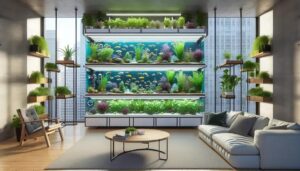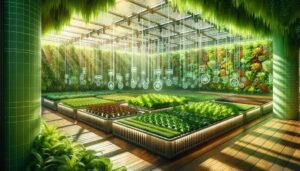Have you ever wondered how to bring nature indoors effectively? Houseplants grown with hydroponic methods and LED lighting can transform your bedroom into a calming sanctuary, offering both aesthetic and health benefits. Let’s see how you can start cultivating this green dream in your own space.
understanding hydroponic systems for houseplants
Hydroponic systems offer a soil-free method of growing houseplants, making them ideal for indoor spaces like bedrooms. These systems use nutrient-rich water solutions to sustain plant growth, allowing for more efficient use of space and resources. There are several types of hydroponic setups, including deep water culture, nutrient film technique, and aeroponics, each with unique benefits.
Deep Water Culture (DWC)
In this system, plant roots are submerged in a nutrient solution, allowing for continuous access to water and nutrients. It’s a popular choice for beginners due to its simplicity and low maintenance needs.
Nutrient Film Technique (NFT)
NFT involves a thin film of nutrient solution flowing over the roots, providing a steady supply of oxygen and nutrients. It’s efficient and popular for growing leafy greens and herbs.
Aeroponics
Aeroponics suspends plant roots in air and regularly mists them with nutrient solution, offering high oxygen exposure and efficient nutrient delivery. This method often results in faster growth but can be more complex to manage.
Each method has its benefits, depending on your plant choice and space. Understand these systems to choose the best fit for your bedroom garden.
choosing the right LED lights for bedrooms
Selecting the appropriate LED lights for your bedroom hydroponic setup is crucial for the growth and health of your houseplants. Not all LED lights are created equal, and understanding their specifications can help you make a wise choice. The key factors include light spectrum, intensity, and energy efficiency.
Light Spectrum
Plants need a full spectrum of light similar to sunlight to thrive. Look for LEDs that provide both red and blue light, as these spectrums are essential for photosynthesis and plant growth. Some advanced LEDs also offer adjustable spectrums to cater to different growth stages.
Intensity
The light intensity needed for your plants depends on the type and size of the plants. Measured in lumens, higher intensity LEDs ensure that plants receive enough light to perform photosynthesis efficiently. Positioning LEDs at the correct distance from plants is also important.
Energy Efficiency
LEDs are popular for their energy efficiency, providing ample light while consuming less power compared to traditional bulbs. Choosing energy-efficient LEDs helps reduce electricity costs and is environmentally friendly.
With the right LED lights, your bedroom can become a lush, green oasis that supports both plant growth and room aesthetics.
setting up a hydroponic garden efficient for small spaces
Designing a hydroponic garden that fits small spaces can transform any bedroom into a thriving green haven. When working with limited space, vertical gardening techniques are essential. Vertical systems maximize growth potential without requiring large horizontal surfaces, which is ideal for compact areas.
Vertical Systems
These systems stack plants in layers, using shelves or specially designed vertical planters. They make effective use of height to cultivate more plants in less floor space. Simple designs can be easily set up, often needing just a wall or corner in a room.
Container Selection
Choosing the right containers ensures healthy plant growth. Use containers that provide adequate root space and have a convenient water delivery system. Materials like plastic or lightweight metal work well without adding much weight.
Lighting Placement
Properly positioning LED lights is crucial. Ensure lights are placed to provide even coverage across all plants. Adjustable fixtures can help target light where it’s most needed as plants grow.
Careful planning and setup make it possible to enjoy a lush, efficient hydroponic garden even in the smallest bedroom spaces.
caring for your hydroponic houseplants effectively
Proper care is essential to ensure your hydroponic houseplants thrive. Regular maintenance and monitoring can vastly improve plant health and yield in your bedroom garden. Key aspects include nutrient management, water quality, and pest control.
Nutrient Management
Hydroponic systems rely on nutrient solutions to provide what plants need. Ensure the nutrient mix is balanced and adjusted to the specific plants. Regularly check and replace these solutions to avoid deficiencies.
Water Quality
High-quality water is crucial for plant health. Regularly monitor pH levels, aiming for a range that supports plant uptake, typically between 5.5 and 6.5. Use filtered or distilled water to minimize unwanted chemicals and minerals.
Pest and Disease Prevention
Even hydroponic systems can fall victim to pests. Regularly inspect plants for signs of infestation. Natural treatments like neem oil or insecticidal soap can be effective. Ensure proper air circulation to prevent mold and fungi.
Consistent care regimes promise vibrant, healthy growth and enhance the indoor gardening experience.
benefits of houseplants: air quality and aesthetics
Incorporating houseplants into your bedroom offers both aesthetic and health benefits, significantly enhancing the environment. Plants act as natural air purifiers, filtering out toxins and improving overall air quality. This not only makes for a healthier living space but also boosts mood and productivity.
Air Quality Improvement
Houseplants absorb carbon dioxide and release oxygen through photosynthesis, creating fresher air. Plants like spider plants, peace lilies, and snake plants are particularly effective in removing indoor pollutants like formaldehyde and benzene.
Aesthetic Appeal
Beyond their health benefits, houseplants add a touch of nature and vibrancy to any room. They offer an easy way to bring life to interior decor with various colors, shapes, and sizes, making them versatile design elements.
Creating a green space with houseplants not only beautifies your home but also contributes to a more balanced and pleasant atmosphere.
common challenges and solutions in hydroponic setups
Setting up a hydroponic system in your home can present several challenges. Understanding these common issues can help you find effective solutions and maintain a thriving garden. One frequent challenge is nutrient imbalance, which can affect plant health. Using a quality nutrient solution and regular testing can help prevent deficiencies or toxicities.
Water Quality Issues
Hard water or pH imbalances can harm plants. Regularly testing water and using filters can address this. Keeping pH levels within the optimal range of 5.5 to 6.5 ensures nutrient uptake.
Pest Management
Pests can still be a problem even with soil-less systems. Regularly inspect plants and use natural pest control methods like neem oil to tackle infestations early.
Temperature and Humidity Control
Maintaining a consistent indoor climate is crucial. Too much heat or humidity can stress plants. Use fans, dehumidifiers, or heaters to create an ideal growing environment.
Addressing these challenges proactively allows for a successful and productive hydroponic setup in your bedroom, promoting healthy plant growth.
Enhancing your home with hydroponic houseplants
Embracing houseplants with hydroponic techniques and LED lighting can transform your bedroom into a green sanctuary. From choosing the right LED lights to setting up efficient systems and overcoming common challenges, each step plays a crucial role in creating a thriving home garden.
The benefits of improving air quality and adding aesthetic value make it worth the effort. As you gain experience, you’ll find maintaining these plants not only rewarding but also a fascinating science. Enjoy the beauty and health benefits houseplants bring to your living spaces.
By understanding and applying the concepts above, you can create a lush, vibrant environment that enhances both mood and health.
FAQ – Common questions about hydroponic houseplants and LED lighting
What are the benefits of using LED lights for houseplants?
LED lights provide a full spectrum of light that is crucial for photosynthesis, helping plants grow indoors efficiently while saving energy.
Can hydroponic systems work in small spaces like a bedroom?
Yes, hydroponic systems can be tailored to fit small spaces by using vertical systems and compact designs, making them ideal for bedrooms.
How do houseplants improve air quality in a room?
Houseplants absorb carbon dioxide and release oxygen. They can also filter out harmful pollutants, improving overall indoor air quality.
What are some common pests in hydroponic gardens and how to manage them?
Common pests include aphids and mites. Managing them involves regular plant checks and using natural remedies like neem oil when needed.
How often should I change the nutrient solution in my hydroponic system?
It is recommended to change the nutrient solution every two weeks to ensure that plants receive a balanced diet and avoid buildup of minerals.
Are there any specific plants that thrive best in hydroponic systems?
Yes, plants like lettuce, herbs, and certain houseplants such as pothos and spider plants thrive well in hydroponic systems.



